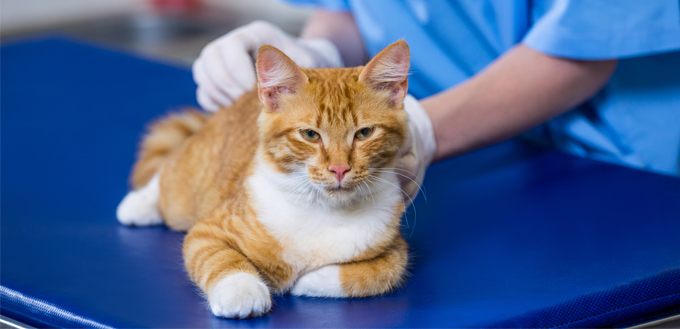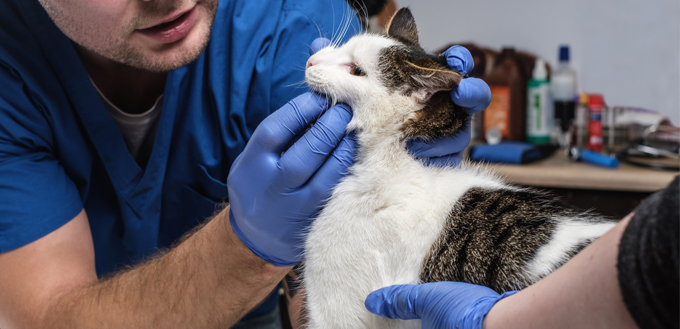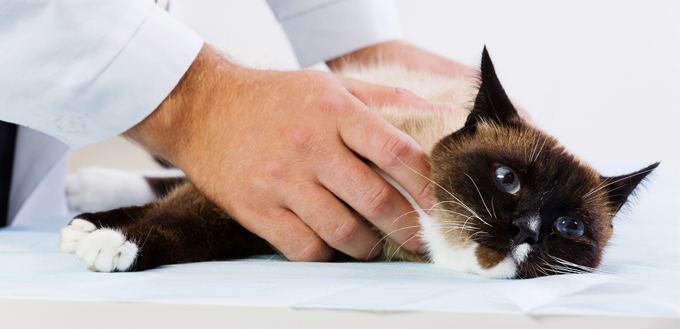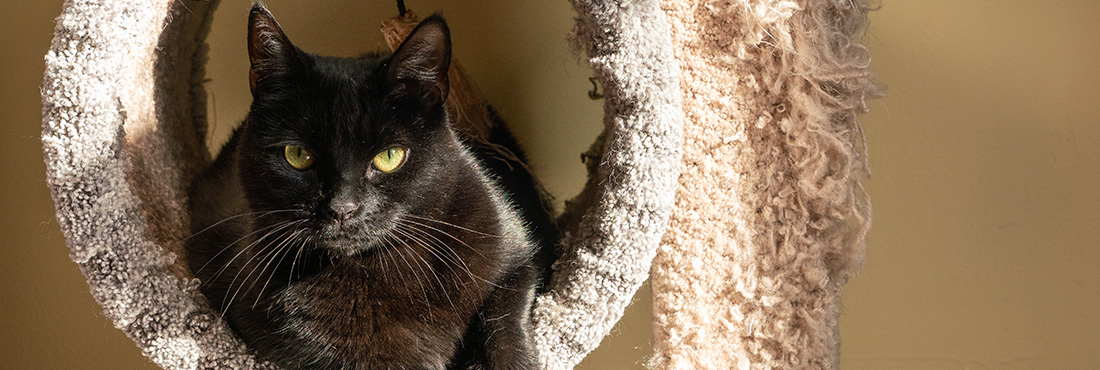Have you noticed dry, crusty pustules or lesions on your cat? If so, these are scabs, and they can range from singular to multiple. There are many different types of scabs, with a variety of causes. The location of the scabs and the symptoms your cat is experiencing will help to give your vet an indication of the cause. With that being said, in this guide, we are going to take a look at scabs on cats and how to treat them, including some useful home remedies for cat scabs.

What are the Causes of Cat Scabs?
As mentioned, there are many different reasons why scabs can form on your cat’s skin. Some of the most common causes are as follows:
- Skin cancer
- A reaction to an insect sting or bite
- Eosinophilia granuloma complex
- Skin infection
- Abscess
- Pemphigus
- Ringworm
- Mange
- Allergies
- Feline acne
- Flea bite hypersensitivity
Diagnosis of the Issue
For your vet to get to the bottom of why your cat is suffering from scabs, a number of different factors are considered and tests are conducted. Your vet will look at the cat’s medical history, as well as conducting a physical examination. Diagnostic tests can include a skin prick test, analysis of the hairs, skin cytology, and skin scraping. The vet may also carry out a baseline test to analyze your cat’s overall health.

Treating Cat Scabs
The treatment chosen will depend on the reason why your cat has developed scabs. Some of the most common treatment options include anti-inflammatory medication, medicated shampoos, diligent parasite control, and antibiotics for the infection. Below, we are going to take a look at the most likely course of treatment for some of the most common causes of scabs…
- Skin cancer
There are a number of different skin cancers that cats can suffer from, including mast cell tumor, squamous cell carcinoma, basal cell carcinoma, and melanoma. Surgery will be required, and this may need to be followed with radiation therapy or chemotherapy.
- A reaction to an insect sting or bite
Insect stings and bites can result in a localized reaction, which tends to cause an intense amount of itching. If you notice just one or two small scabs on your cat, the cause is most likely an insect sting or bite. Treatment involves using Benadryl, which is an antihistamine, to control discomfort and itching.
- Eosinophilia granuloma complex
This is a condition that is characterized by lesions being on the skin across various areas of your cat’s body. The exact cause for this condition is not known. Nevertheless, it is believed to come from inhalant allergens, food allergens, or flea bites. For some cats, the condition comes and goes, whereas others only experience this condition once. To treat eosinophilia granuloma complex, you need to get rid of the allergen exposure if this is possible. You can also use an antihistamine like Zyrtec to relieve symptoms. Surgical removal could be required if the lesions are not responsive.
- Skin infection
Your cat may have developed a skin condition. One example is pyodermas, which is a skin infection caused because of trauma. Topical antibiotics and oral antibiotics are typically applied to the area that is affected.
- Abscess
An abscess can reside on your cat’s teeth or skin, and it is a pocket of pus that forms when bacteria enters the body through a puncture wound, typically caused during a cat fight or because of a bite. The treatment depends on whether the abscess can be drained or not.
- Pemphigus
This is a group of rare bullous autoimmune diseases in felines, which tends to occur because your cat has an overactive immune response against its own tissues. Treatment for this will begin with immunosuppressive drugs. If they fail, your vet may recommend a chemotherapy drug, known as Chlorambucil.
- Ringworm
Ringworm is a common fungal infection, which impacts the nails, fur, and skin of cats. It is caused by dermatophytes, which is a microscopic group of parasitic fungal organisms. Ringworm invades the outer, dead layers of the hair, claws, and skin. The name ringworm has been given because of the fact that circular lesions, which appear like a ring, tend to develop on the skin of the cat infected. In areas of high temperatures and humidity, fungus is more common. Moreover, cats in a crowded environment, for example, a shelter or a cattery, is at greater risk. If your car has been diagnosed with ringworm, you will need to not only treat your pet but you will need to treat your home too. If you have more than one cat, you need to ensure they are all treated. In most cases, your vet will prescribe a dip or shampoo for ringworm. It is crucial to take care when you are looking after your cat, as ringworm can easily spread from cats to humans and vice versa.

- Mange
Mange is caused when a parasite, which is like a tiny spider, burrows itself into the skin of your cat. This is a condition that is highly contagious. Symptoms include intense scabs and itching, particularly along the margin of the ear, which often ends up becoming thickened. The most commonly affected areas are the neck ad the head. However, the mite can move to over parts of your cat’s body if this condition is left untreated, which is why it is important to act quickly. There are a number of different treatment options available. This includes a wide range of dips and products, for example, revolution, and ivermectin.
- Allergies
Cats can be allergic to a wide range of things, and food most certainly falls into this category. It is also worth pointing out that some cats can develop an allergy to a certain type of food, despite the fact that they used to it. Food allergies usually impact the neck, ears, and head area, resulting in non-seasonal itching. This can then lead to large areas of one and weeping scabs, as well as small papules. If your cat has scabs and hair loss; it is likely that a food allergy is the problem. Other symptoms include excessive licking of the area that is affected and vomiting. If your cat is diagnosed as having a food allergy, he will be put on a novel diet, i.e. a type of food that he has never eaten before. This is used to see whether or not the symptoms will clear up. Of course, food allergies are not the only types of allergies your cat may have. It could be that your cat has an inhalant allergy, i.e. an allergic reaction caused by breathing in airborne particles, for example, molds, storage mites in dry food, dust mites, and pollens. While humans are most likely to react to this by wheezing and sneezing, cats tend to develop skin issues as a reaction.
Related Post: Best Hypoallergenic Cat Food
- Feline acne
Another reason why your cat may have scabs is that he is suffering from feline acne, which is a condition whereby inflammation and blackheads develop on your cat’s skin. There are numerous causes of feline acne, including poor grooming, inflammation, allergies, and the use of plastic food bowls. If you have noticed blackheads on your cat’s skin, which appear like dirt, it is highly likely your cat has feline acne. The blackheads can become inflamed, causing swelling, as well as scabs and crust. To treat feline acne, there are a number of different things you need to do. This includes using an antibiotic soap to clean the area. You should also treat secondary infections by using oral antibiotics, and you should use metal bowls instead of plastic bowls. Strict hygiene is imperative too. Wash water bowls and food bowls using soapy, hot water after they have been used.
- Flea bite hypersensitivity
Finally, we have flea bite hypersensitivity, which is actually the most common cause of scabs on cats. Fleas live on your pet’s skin. They are windless parasites, which will feed off your cat’s blood. A lot of cats have a localized reaction because they have an allergy to the saliva in flea bites. This can cause small, raised crusty bumps to develop around your cat’s chin and neck, as well as on your cat’s back, just in front of his tail. In order to cure this form of scabs, diligent flea control is a necessity. Not only do you need to ensure that your cat is kept flea-free but you also need to make sure the environment is treated as well.
Hopefully, you now have a better understanding of what scabs are and how they are caused. If you have noticed any of the symptoms mentioned in this article, you should try the home remedies suggested to help your cat. However, if the issue won’t seem to budge or it is getting worse, it is important to take your cat to the vets at the nearest opportunity.
Sources:
- Remedies for Cat Scabs, WebMD
- Matthew Everett Miller, DVM, Common Cat Skin Conditions, PetMD
- Tammy Hunter, DVM, Allergies in Cats, VCA Hospitals






